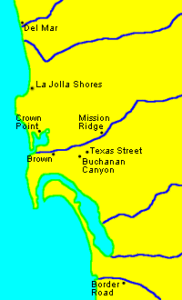Pleistocene Occupation
The question of whether or not people occupied the San Diego region earlier than the final millennium or two of the Pleistocene Epoch has been embroiled in controversy for decades. Key points in the sometimes acrimonious debate have concerned the natural or human origins of supposed artifacts and features, and their chronological placement.
If there were any earlier Pleistocene occupations in North America, western San Diego County may be a comparatively promising area to look for evidence of them. Located along a hypothetical coastal corridor from northeast Asia, the region has been relatively stable tectonically, but it was slowly uplifted during the Pleistocene and is now characterized by well-preserved marine terraces and alluvially filled valleys (Carter 1996). The La Jolla submarine canyon, a major feature of southern California’s offshore topography, may have produced particularly favorable conditions for the discovery of early coastal sites. The steep terrain around the canyon has meant that the horizontal shifts in the shoreline that attended rising or falling sea levels were relatively small. Coastal sites associated with periods of lowered sea level may therefore lie close to the modern shore.
 Over several decades, George F. Carter (1949, 1950, 1952, 1954, 1955, 1957, 1978, 1980, 1996) was the leading advocate for a Pleistocene human presence in the San Diego region. His arguments were based primarily on the geological contexts of the Texas Street Site and other deposits that he correlated with glacial and interglacial periods. He also noted the crudeness of the lithic assemblages found in these contexts and their dissimilarity to later technologies. Many critics quickly questioned the human provenience of Carter’s hearths and “cartifacts” (e.g., Haury 1959; Krieger 1958; Johnson and Miller 1958; Wormington 1957), although other investigators offered support (Cressman 1977; Sellards 1960; Simpson 1954; Witthoft 1955). Carter continued to argue and elaborate his case in defiance of the prevailing archaeological orthodoxy, dating the earliest human occupations back several hundred thousand years before the present.
Over several decades, George F. Carter (1949, 1950, 1952, 1954, 1955, 1957, 1978, 1980, 1996) was the leading advocate for a Pleistocene human presence in the San Diego region. His arguments were based primarily on the geological contexts of the Texas Street Site and other deposits that he correlated with glacial and interglacial periods. He also noted the crudeness of the lithic assemblages found in these contexts and their dissimilarity to later technologies. Many critics quickly questioned the human provenience of Carter’s hearths and “cartifacts” (e.g., Haury 1959; Krieger 1958; Johnson and Miller 1958; Wormington 1957), although other investigators offered support (Cressman 1977; Sellards 1960; Simpson 1954; Witthoft 1955). Carter continued to argue and elaborate his case in defiance of the prevailing archaeological orthodoxy, dating the earliest human occupations back several hundred thousand years before the present.
A follower of Carter was Herbert L. Minshall (1973, 1974, 1975, 1976, 1978, 1981, 1985, 1989; Moriarty and Minshall 1972). Minshall reviewed broader arguments for a Pleistocene human presence in North America in two well-illustrated books. In particular, he discovered and investigated the Buchanan Canyon Site, located not far from Texas Street near Mission Valley. Carter, Minshall, and James R. Moriarty III conducted excavations at the Texas Street and Buchanan Canyon sites. Moriarty, Minshall, and Brian F. Smith also excavated the Charles H. Brown Site, which was interpreted as a multicomponent deposit containing Holocene San Dieguito, La Jolla, and Kumeyaay materials underlain by Pleistocene deposits older than 60,000 years.
Partial support for the views of Carter, Minshall, and Moriarty came from investigations at the Mission Ridge Site by Brian O. K. Reeves, John M. D. Pohl, and Jason W. Smith (1986). Shallow excavations in a middle Pleistocene terrace recovered an assemblage of quartzite cobble fragments. Although a natural origin was suggested for “bipolar” fragments and spalls, some of the other specimens were interpreted either as intentionally percussion-flaked tools or as manuports. The assemblage was considered to be closely similar to the materials found earlier by Carter at the Texas Street Site. Reeves (1985) also investigated sites at La Jolla, Torrey Pines, and Otay River.
Although human skeletal remains are unambiguously cultural, their dating may be problematic. For a time in the 1970s and 1980s, the amino acid racemization method, developed locally by Jeffrey L. Bada, seemed to offer promise for dating Pleistocene bone (Bada and Helfman 1975; Bada and Masters 1978; Bada et al. 1974; Darling 1984). Human skeletal material from the Del Mar Site (SDM-W-4) was dated as about 46,000 years old by this method. Material from La Jolla was given ages of 27,000, 28,000, 39,000, and 44,000 years, and a sample from Batiquitos Lagoon was estimated as 46,000 years old. However, the subsequent redating of many of the skeletal remains by the AMS radiocarbon method discredited the original amino acid racemization results (Bada 1985a; Bada 1985b; Bada et al. 1984; Taylor 1983; Taylor et al. 1985). Del Mar Man was redated as only about 5,000 years old, and the La Jolla bones were similarly redated to the middle or late Holocene.
PROSPECTS
The question of a human occupation in the San Diego region prior to the terminal Pleistocene Epoch remains unsettled. Future archaeological excavations, replicative experients, and observations of geological processes and materials may be able to shed light on the human or natural origin of “crude” cobble assemblages. New strategies may be applied to dating cultural materials found in contexts that are suggestive of a Pleistocene antiquity.